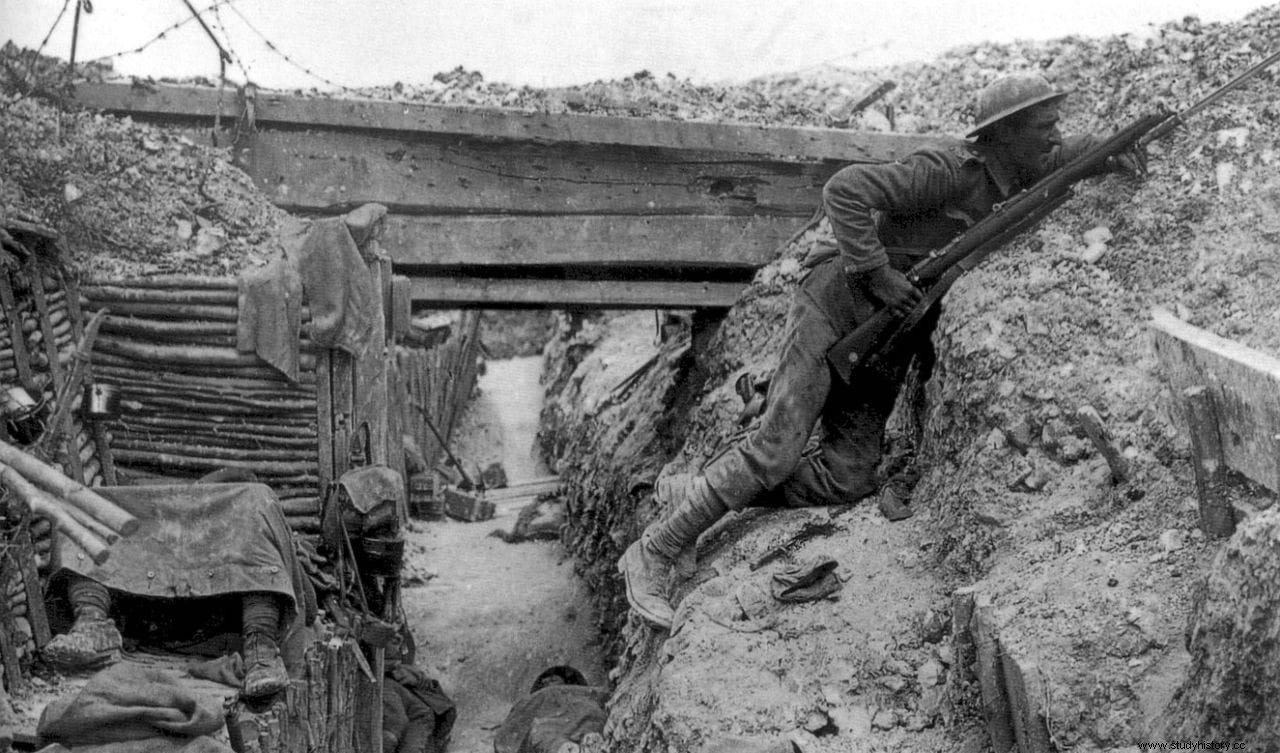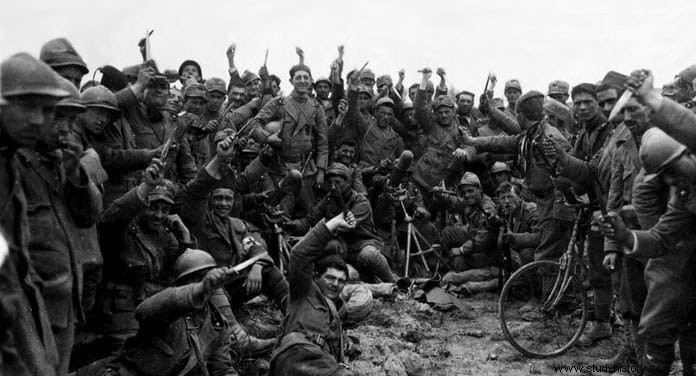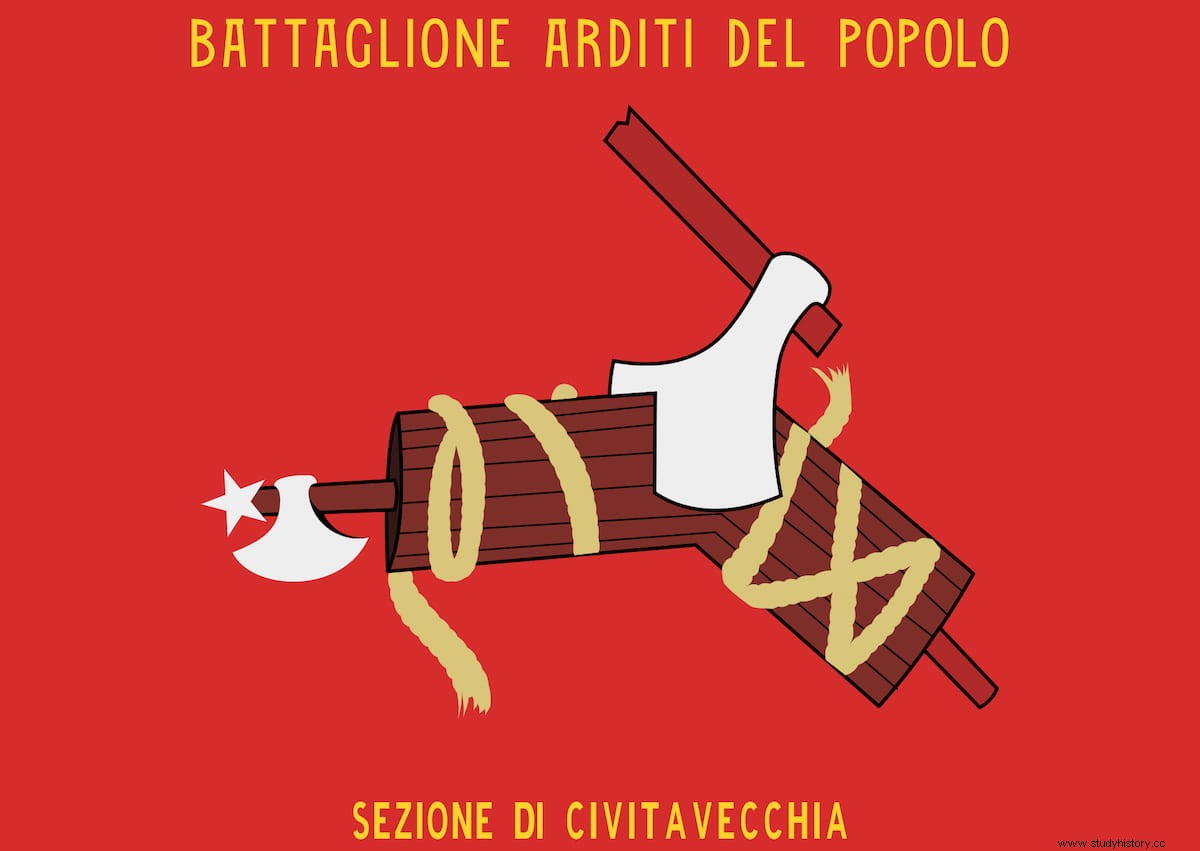The 9º Reggimento d’Assalto Paracadutisti Col Moschin , one of the elite forces of the Italian army, is popularly known as Arditi incursori , which means "bold raiders". But this nickname derives not so much from its operational capacity as from its historical background:a shock corps created during the First World War to resolve the stalemate caused by trench warfare at the front and which received the name of Arditi .
Let's go back to the time. From the end of 1914 the fronts tended to stabilize, stopping offensive operations and turning the border territory between contenders, the northern part of France and Belgium fundamentally, into an area pierced by kilometers and kilometers of defensive constructions with ditches, parapets and barbed wire that neither side was able to overcome. Neither the artillery bombardment nor the release of gases in 1915 nor the appearance of the first tanks the following year - still too primitive - could prevent that bogging down of troops that, in practice, caused enormous numbers of casualties due to illness due to the terrible hygienic conditions .
In such circumstances and taking into account that the massive foot charges of the soldiers failed as they were easy fodder for the machine guns, in 1917 the Regio Esercito had the idea of organizing what he called Reparti d’Assalto , assault units in charge of paving the way to make way for the bulk of the infantry with actions on specific points. This contingent adopted on its own initiative the name of Arditi because its members were recruited among the bravest of each regiment, which leads to place its origin in other previous, smaller units, which began to operate in 1914 behind enemy lines, in the manner of commandos, although they used to perform tasks exploration.

Another body that undoubtedly influenced the creation of the Arditi it was the one of the Companies of death , in charge of clearing the land of wire fences -cutting them with shears or blowing them up- to facilitate large-scale assaults. These companies had their own characteristic uniform that identified them as a separate unit, although each regiment had its own. In any case, the spirit was clear:attack the enemy trenches to open the way and hold out until the arrival of their own. In fact, the Germans also had their version:the Stosstruppen , which should also have served as a model.
Or the victory, or tutti accoppati was his motto, translatable as "Either we win or we all die." Very adjusted to reality, since the percentage of casualties they recorded was impressive, much higher than normal:up to thirty percent. Perks of the type of combat they had to play, which often forced them to do without their rifle in favor of Thevenot grenades and firecrackers (a low-power hand bomb, ideal for launching inside the same trench), as well as a pistol and a simple dagger; the first ones to throw on the adversaries and eliminate most of them and the others for the fight in short distance that they would have to develop in the narrow space of the trench with the survivors, once they had entered inside. They also used to wear an armored breastplate.
That uniqueness of their trade meant that they received special training, not only in intensity but also in variety. They learned self-defense, hand-to-hand knife fighting and everything related to the use of hand grenades, although they also practiced with other weapons. Actually, most of the Arditi they were already superior soldiers before, because apart from having to pass psychological tests they used to come from bodies like the Bersaglieri and the Alpini , in which mobility required strong and resistant limbs. The uniform itself had elements of both, the main ones being an insignia with flames (of a different color depending on the unit), another with the typical knot of the Savoy house and the initials VE (alluding to King Vittorio Emanuele III, signs that came from a decoration for previous bravery); the most surprising thing was that they were covered with a fez (also of variable color) that in combat was exchanged for a helmet.
Despite the reluctance of the high command, the Arditi they were strictly organized in mid-1917 and integrated into the 48th Division of the VIII Army Corps commanded by Colonel Giuseppe Bassi, who obtained the determined support of General Francesco Saverio Grazioli. Each unit had about four hundred men, all volunteers, under the command of thirteen officers, making a total of eighteen thousand troops. Their initial base was located in Sdricca di Manzano, a town in the Italian province of Udine (where, by the way, today they are remembered with a party every summer) and no criminal record was admitted. In general, the Arditi they were not well seen by the other soldiers due to the prerogatives they enjoyed.

It is not clear where his baptism of fire took place. Managing the dates broadly, the Compagnia volontari esploratori could be reviewed. of Captain Cristoforo Baseggio, which was completely destroyed in April 1916 in the attack on Monte Osvaldo and was dissolved a month later. Baseggio is sometimes named as the creator of the Arditi , but these same ones denied it in his day and we could consider him one more among the many fathers of his. Thus, the reference year is 1917. Specifically on May 14, with the assault on Monte San Marco by Bassi's men, which was what gave the green light to the creation of the body and its entry into action as such on August 18 at Monte Fratta:Two companies crossed the Isonzo River by surprise and took five hundred prisoners. Three weeks later another three companies increased the feat capturing three thousand Austrians and twenty-eight cannons on Mount San Gabriel.
That autumn they participated in the famous battle of Caporeto (a serious defeat that caused Bassi to be replaced by General Capello), just as they did exactly one year later in Vittorio Veneto. However, his most famous action was in the summer of 1918, during the Battle of the Piave. Desperately waged along the homonymous river to stop the Austrian advance, it ended with a victory that gave Italy a break, removing the threat of invasion that had caused the defeat in the aforementioned Caporeto. The Arditi staged several night raids among the enemy, swimming across to the other shore to stab opposing soldiers, earning the nickname Caimani del Piave (Caimans of the Piave); the current COMSUBIN (Subacquei and Incursori Command ) use that reptile as an emblem in their memory.
In 1920, after the war and being unnecessary, the Arditi they were demobilized. However, his paraphernalia was adopted by both the Mussolini regime and the self-baptized anti-fascist militia Arditi del Popolo; both used as symbol the skull with a dagger between the teeth that the soldiers showed. However, many veterans, unable to readapt to civilian life as happened in Germany, joined the ANAI (Associazione Nazionale Arditi d’Italia ) of Captain Mario Carli, an intellectual ex-ardito who supported the movement of the poet Gabriele D'Anunzio in the Croatian city of Fiume to create a free state linked to Italy. D'Anunzio called himself Duce and he controlled the power through a militia he called Arditi ; its members wore a black shirt -later copied by Mussolini- and a typical fez of the same color.

In 1921 Carli moved away from proto-fascism to collaborate in the founding of the aforementioned group Arditi del Popolo , of radical leftist and republican character. He often clashed with fascists in street fights shouting "A noi!" (For us!) Parma in 1922 being the most serious, with the participation of hundreds of people from both sides and dozens of registered deaths. With the rise to power of Mussolini that same year the Arditi dei Popolo they began to be persecuted; by then, Carli had abandoned them and re-embraced fascism.
